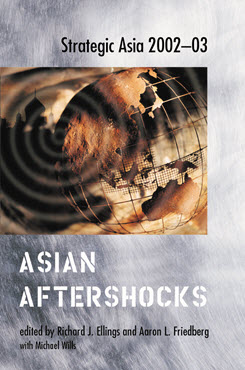United States (Strategic Asia 2002-03)
The purpose of this chapter to is to offer a preliminary assessment of the implications of September 11 for America’s position in, and strategy toward, Asia.
The history of U.S. involvement in Asia has been punctuated by a sequence of memorable dates and dramatic developments: Admiral George Dewey’s destruction of the Spanish Fleet in Manila Bay on May 1, 1898, the Japanese attack on Pearl Harbor on December 7, 1941, and theNorth Korean invasion of the South on June 25, 1950. Each of these events was followed by a major, largely unplanned, expansion in the tangible manifestations of U.S. power in Asia and, somewhat more gradually and subtly, by an eventual broadening in the conception of American interests and responsibilities in the region.
The recent terror attacks on the United States were the work of shadowy groups intent on killing large numbers of American civilians rather than conventional acts of war by traditional nation-states. Whether this will lessen their ultimate impact on the conduct of U.S. foreign policy or make it more dramatic remains to be seen. Nevertheless, while it is too early to say with certainty, it may well be the case that September 11, 2001, will turn out to have been yet another turning point in America’s career as an Asian power. Although they took place on the East Coast of the United States, the events of that day had an impact that quickly reverberated back to Afghanistan, and then radiated outward across all of Strategic Asia.
Today the United States finds itself engaged militarily, diplomatically, and economically in Afghanistan, Central Asia, and South Asia in ways that would have seemed fanciful if they had been described only one year before. The crisis has contributed to what appears to be a transformation in the U.S. relationship with Russia and, to varying degrees, it has had a significant impact on America’s dealings with China, Japan, India, Pakistan, North and South Korea, Taiwan, the Philippines, Indonesia, and Malaysia, among others. Nor is this a story whose ending is yet certain. The aftereffects of the attacks on New York and Washington are still being felt, and there may be further shocks to come.
The purpose of this chapter to is to offer a preliminary assessment of the implications of September 11 for America’s position in, and strategy toward, Asia. It will begin with a review of the changes in U.S. Asia policy introduced by the George W. Bush administration during its first nine months in office. After a brief description of the U.S. response to the terrorist attacks as it has unfolded to date, it will then examine the wider implications.
These can be summarized under three headings: September 11 has caused the United States to broaden its presence in and engagement with key parts of Strategic Asia; it has tended to strengthen America’s relationships with its primary strategic partners, both formal allies and quasiallied democracies; and the crisis has served to intensify the competitive aspects of U.S. relations with those countries that it has long regarded with suspicion, especially North Korea and China. Each of these features of the recent changes in the U.S. posture in Asia carries with it both risks and opportunities, which will be discussed in the closing section.
Strategic Asia
The Strategic Asia annual edited volume incorporates assessments of economic, political, and military trends and focuses on the strategies that drive policy in the region. Learn more about Strategic Asia.


